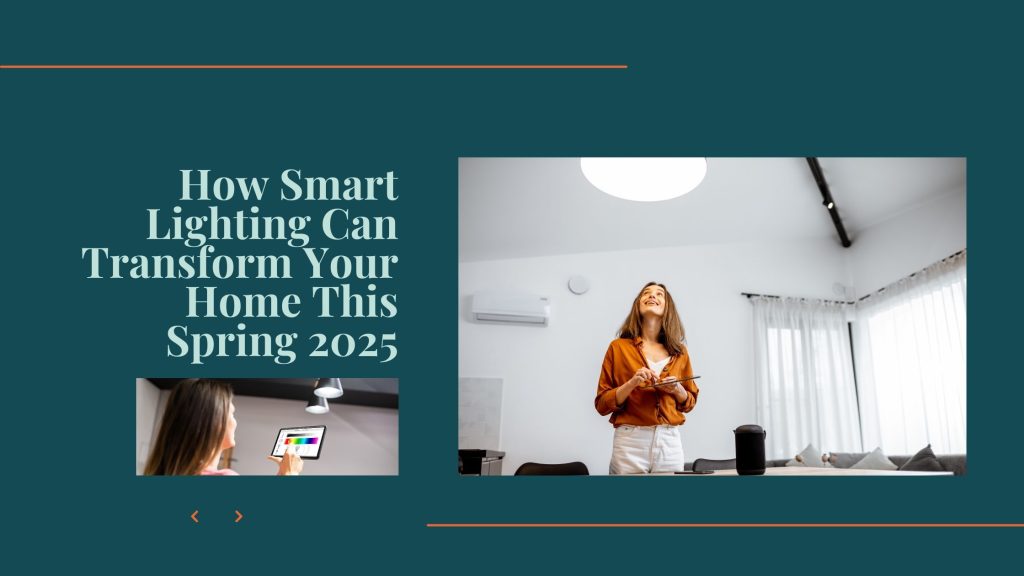Spring 2025 is here—and it’s not just your wardrobe or garden that deserves a refresh. One of the simplest yet most impactful upgrades you can make to your home this season is investing in smart lighting for spring 2025. From boosting energy efficiency to enhancing your home’s ambiance, smart lighting systems offer convenience, comfort, and control like never before. Whether you’re new to smart home tech or looking to expand your existing setup, this guide covers everything you need to know about smart home lighting setup, including the top systems, benefits, and setup tips.
Why Spring is the Perfect Time to Upgrade to Smart Lighting
Spring symbolizes renewal, and that makes it the perfect season to modernize your home’s lighting. Here’s why now is the ideal time to make the switch:
1. Longer Days, More Light Control
As the days grow longer, smart lighting allows you to automate your indoor and outdoor lights to complement natural daylight. With schedules and sensors, your lighting will seamlessly adjust to match the changing sunrise and sunset.
2. Spring Cleaning and Decluttering
Upgrading to smart lighting is an excellent part of your spring refresh. Swapping outdated bulbs and fixtures for sleek, modern smart lights can simplify your setup and reduce the need for manual switches and cluttered outlets.
3. Outdoor Lighting Opportunities
Spring brings more time spent outdoors. Smart lighting helps you create a cozy, well-lit patio, porch, or garden. With weather-resistant smart bulbs and timers, your exterior spaces can shine with the same sophistication as your interiors.
4. Energy Efficiency in Time for Summer
Get ahead of rising summer energy bills by installing energy-saving lighting solutions now. Many smart lighting systems offer dimming and automation features that significantly reduce power usage.
Benefits of Smart Lighting for Your Home in 2025
The benefits of smart lighting go well beyond turning lights on and off with your phone. In 2025, smart lighting technology offers a range of features that improve your home’s energy use, ambiance, and safety.
1. Convenience and Automation
Smart lighting lets you control lights remotely through apps or voice assistants like Alexa, Google Assistant, or Siri. You can automate your lights to follow a schedule or trigger them based on occupancy, making your home feel more intelligent and responsive.
2. Enhanced Ambiance and Customization
From dimming lights for movie night to setting the perfect color for dinner parties, smart lighting allows endless personalization. With millions of color options and adjustable brightness, your home’s mood is just a tap away.
3. Improved Home Security
Integrating smart lighting with security systems can deter intruders. You can schedule lights to mimic your presence when you’re away or use motion sensors to trigger lights in entryways.
4. Health and Wellness
Some best smart lighting systems now include circadian lighting features. These automatically adjust color temperatures throughout the day to support your body’s natural rhythms, helping you wake up more gently and sleep better at night.
5. Energy Efficiency
With automated schedules and dimming capabilities, smart lighting can help reduce electricity consumption. Most systems use LED bulbs that consume up to 80% less energy than traditional incandescent bulbs.
Top Smart Lighting Solutions for Every Room
With so many choices on the market, finding the best smart lighting systems can feel overwhelming. Here are top recommendations for different areas of your home in spring 2025:
1. Philips Hue
One of the most popular and versatile options, Philips Hue offers a wide range of smart bulbs, light strips, and fixtures. Compatible with major smart home systems, Hue is perfect for both beginners and advanced users.
2. LIFX Smart Lights
Known for their vivid colors and brightness, LIFX bulbs don’t require a hub and connect directly to Wi-Fi. They’re great for people looking for powerful lighting without added hardware.
3. Govee Smart Lighting
Govee offers budget-friendly LED strips, bulbs, and light panels that are easy to install and control. Their RGBIC technology allows multiple colors to be displayed on one strip, making them ideal for creative or entertainment spaces.
4. Nanoleaf Shapes and Lines
For those who want to turn lighting into wall art, Nanoleaf offers modular, touch-reactive panels that sync with music and visuals. Perfect for gaming rooms, offices, or living rooms.
5. TP-Link Kasa Smart Bulbs
For those on a budget, TP-Link Kasa smart bulbs provide excellent features like voice control, scheduling, and dimming without requiring a hub. They’re perfect for bedrooms, bathrooms, or smaller spaces.
How to Set Up and Control Your Smart Lighting System
Installing and configuring your smart home lighting setup is easier than ever in 2025, even for beginners. Follow these steps for a smooth installation process:
1. Choose the Right Platform
Before buying smart lighting, decide on a platform like Amazon Alexa, Google Home, or Apple HomeKit. Sticking to one ecosystem ensures compatibility between your lighting and other devices.
2. Install the Bulbs or Fixtures
Most smart bulbs simply screw into existing sockets. For LED strips or fixtures, follow the manufacturer’s installation guide. Make sure your lights are compatible with your home’s Wi-Fi (2.4 GHz is standard).
3. Download the App
Each brand has its own app (e.g., Philips Hue, LIFX, Govee). Use the app to connect your devices to Wi-Fi and assign them to rooms or groups.
4. Create Schedules and Automations
Set daily routines like turning on lights at sunset or off at bedtime. Some systems also support geofencing, so your lights adjust when you leave or return home.
5. Use Voice Control
Pair your lights with a voice assistant for hands-free control. Say, “Turn off the living room lights” or “Set kitchen lights to warm white,” and your lighting will respond instantly.
Energy Savings with Smart Lighting: How It Works
One of the most practical reasons to invest in energy-saving lighting solutions is the long-term savings on utility bills. Here’s how smart lighting helps you save energy:
1. Dimming Reduces Consumption
Smart lights can be dimmed without reducing functionality. Lower brightness means less power usage, especially when full brightness isn’t needed.
2. Automated Schedules
Lights that automatically turn off when not needed help avoid wasted electricity. Schedule lights to shut off during daylight or late at night.
3. Motion Sensors and Occupancy Detection
Installing motion sensors ensures lights are only on when someone is present. This is ideal for areas like hallways, closets, or bathrooms.
4. Remote Access
Forgot to turn off the lights before leaving home? Use your app to switch them off remotely and prevent unnecessary energy waste.
5. LED Technology
Most smart lighting for spring 2025 uses LED bulbs, which last longer and consume less energy than incandescent or CFL bulbs. LEDs can last up to 25,000 hours and use up to 80% less energy.
Conclusion
Upgrading to smart lighting for spring 2025 is one of the most efficient, stylish, and impactful ways to enhance your home. Whether you’re focused on reducing your carbon footprint, boosting security, or simply enjoying the convenience of voice-controlled lighting, the right smart setup can truly transform your space. With numerous benefits of smart lighting, a variety of best smart lighting systems, and practical ways to save energy, there’s never been a better time to light up your home intelligently.
Make the switch this spring—and see your home in a whole new light.



